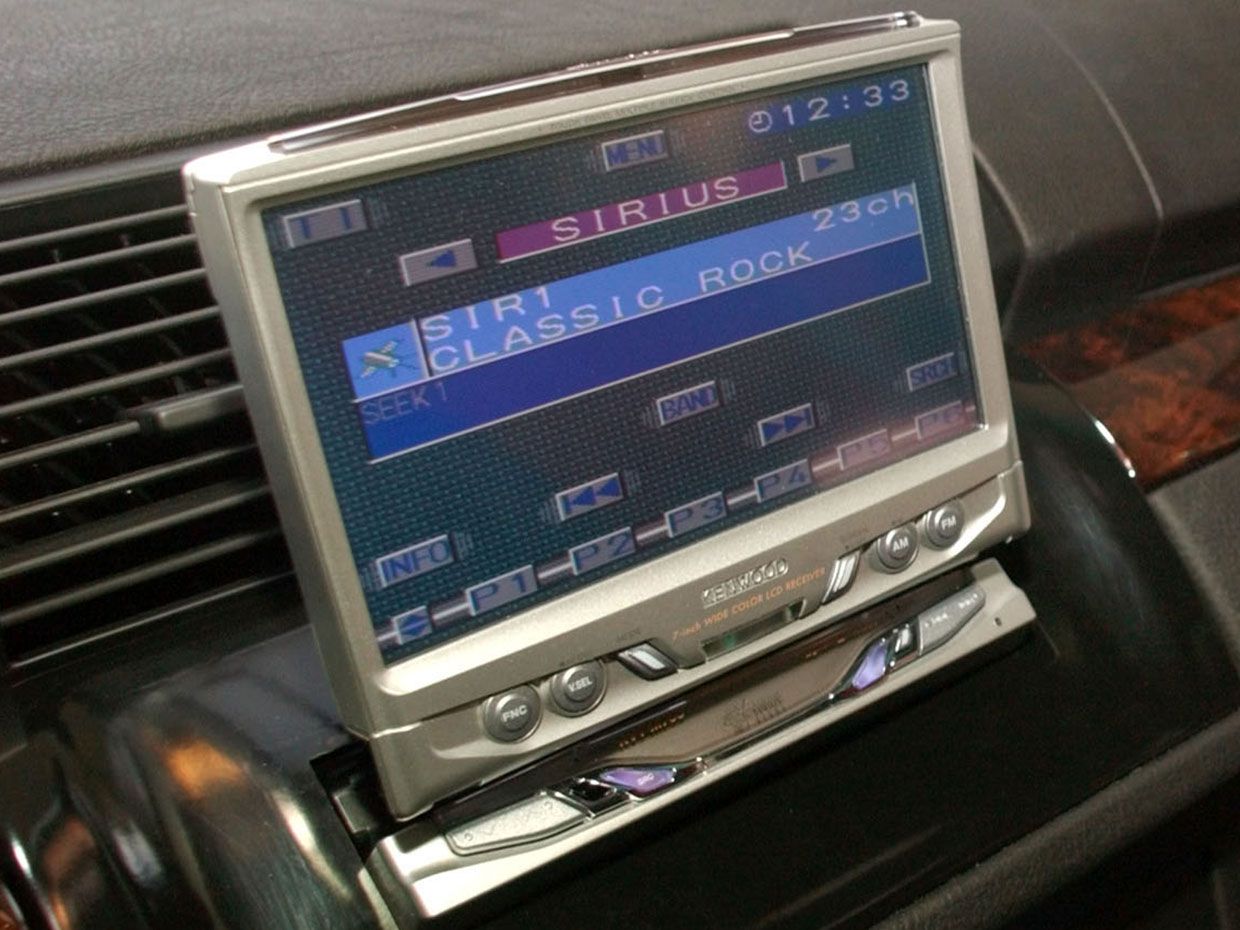The Consumer Electronics Hall of Fame: SiriusXM Satellite Radio System
 Photo: David Zalubowski/AP Music From Space: In February 2002, as the Sirius Satellite Radio music service went on line, the company held a demonstration in Denver. A receiver mounted in a BMW X5 was tuned to Sirius's classic rock channel.
Photo: David Zalubowski/AP Music From Space: In February 2002, as the Sirius Satellite Radio music service went on line, the company held a demonstration in Denver. A receiver mounted in a BMW X5 was tuned to Sirius's classic rock channel.  Enter Here < Back to Consumer Electronics Hall of Fame
Enter Here < Back to Consumer Electronics Hall of Fame Listening to the radio and driving are as inextricably linked as peanut butter and jelly. Even if you've never cruised a boulevard with the top down and the radio blaring, you've probably heard about how great it is in a Beach Boys song (which you probably heard on the radio while driving in your car).
Even so, right from the beginning, listening to the radio in a car had its frustrations. Satellite radio was conceived as the answer to all the things that were irritating about terrestrial broadcast radio.
Complaint No. 1? Advertisements. Conventional, broadcast radio is ostensibly free, so long as you're willing to subject yourself to the shouty ads that commercial radio stations survive on. Another irritation: the lack of variety. In most countries, commercial radio is dominated by cheesy pop music along with, in parts of the United States, big pockets of talk shows, country, salsa, or Mexican formats such as banda and mariachi. If you're into classical, jazz, folk, or indie rock, good luck finding a station. Yet another problem is the relatively limited geographical coverage of most stations. On a long trip, it usually seems like the moment you start warming to a station you're exiting its coverage map. Furthermore, depending on where you are in the world, the number of stations might be few. Some places are completely out of reach of any signals at all.
Satellite radio, on the other hand, is subscription based, so there are no ads. There are scores of different channels, so there's something for everybody. Partial to '80s hair bands? The Grateful Dead? "Emotionally driven alt rock"? There are channels for that. Moreover, every single channel is available everywhere there is service. And if there's sky above you, you're going to get a signal.
Those may have been the justifications for creating the Sirius Satellite Radio system, but they weren't the reason, according to Robert Briskman, one of Sirius Radio's cofounders.
Briskman's experience with satellite technology goes way back. He got a job with NASA in 1959, the year after it was founded, and then worked for the Communications Satellite Corp. (Comsat) and after that with Geostar Corp. In 1990, one of Briskman's friends founded a company to compete with cable TV providers. The startup planned to broadcast residential TV services directly from an orbital satellite. Briskman offered his technical expertise.
"I was helping Eddy Hartenstein bring DirecTV to the home, and I suggested adding radio channels to the video channels," Briskman told IEEE Spectrum. "He said, 'You know, Rob, people at home look at television, and they listen to radio in the car.' And I said, 'You're right, Eddy, why don't we do it in the car?' So he said, 'That's technically impossible.' Those were fighting words to me."
 Photo: Karl Ronstrom/Reuters Ready for Liftoff: The first rocket carrying a Sirius satellite into orbit was launched on 5 September 2000. Four days before launch, Sirius cofounder Robert Briskman [center] met Bob Prevaux [left], of satellite builder Space Systems/Loral, and Ted Sitek, of International Launch Services.
Photo: Karl Ronstrom/Reuters Ready for Liftoff: The first rocket carrying a Sirius satellite into orbit was launched on 5 September 2000. Four days before launch, Sirius cofounder Robert Briskman [center] met Bob Prevaux [left], of satellite builder Space Systems/Loral, and Ted Sitek, of International Launch Services. Satellite communication is contingent on maintaining line of sight (LOS) between satellite and receiver. What made satellite radio seem impossible was that vehicles were inevitably going to pass under bridges, drive under tree canopies or into parking garages, enter tunnels, or become isolated in deep canyons of the natural or urban variety.
The challenge facing Briskman was to design satellites and complementary receivers that would somehow maintain LOS as much as possible. If you were to drive into an underground garage and park, the signal would be lost, and nothing could be done about that. But if LOS was lost only briefly, there had to be some way to make sure the receiver could keep on playing until it could pick up the signal again.
Briskman, an IEEE Life Fellow, says it took him seven or eight years and at least five patents' worth of technology to make the impossible a reality.
A big part of the solution to maintaining a LOS connection between receiver and satellite was satellite diversity. "It just means putting two satellites up there radiating the same signal, but you put them in different parts of the sky. If the car is blocked from one satellite, it hopefully has a clear line of sight to the other," Briskman explains.
 Image: Edison Research Who's Listening: The likelihood of a U.S. resident older than age 13 listening to satellite radio rather than conventional broadcast radio in a car goes up sharply with the newness of the car.
Image: Edison Research Who's Listening: The likelihood of a U.S. resident older than age 13 listening to satellite radio rather than conventional broadcast radio in a car goes up sharply with the newness of the car. In cities with tall buildings, the satellites are supplemented by terrestrial repeaters, land-based antennas that beam signals directly into urban canyons. Those measures meant motorists listening to Sirius were almost always going to get a signal, but "almost always" wouldn't be good enough. There are hundreds of thousands of underpasses in the United States alone, Briskman noted, and going under any one of them could block both satellites.
"The solution to that was another patent, for satellite-time diversity," Briskman says. "It simply means having two satellites radiating the same signal, but we delay one for, say, roughly 5 seconds."
The receiver contains a 5-second buffer, so that if the satellites are blocked, the receiver plays out the buffered data. If you're out of sight of a satellite for more than 5 seconds, you get an outage, but 5 seconds turned out to be enough to get most Sirius subscribers through most underpasses without program interruption.
The receiver is where incoming signals are decoded and decrypted. The Sirius radio is unusual, Briskman says, because it actually has three independent receivers, one each for the two satellites and one for terrestrial repeaters. To deal with three separate receivers, he devised what he called a maximal-ratio combiner. If there are two or three strong signals from the receivers, this circuit puts them in phase and-as the name suggests-combines them. Conversely, if one or two of the signals is bad, it suppresses them.
And the Sirius radio actually comprises two separate units. There's the first, the one with the receivers, in the vehicle cabin. That's the part that looks like a typical dashboard radio with a display screen. The other is mounted on the roof or the trunk. It holds the antenna and a low-noise receiver. It takes the signals coming in from the satellites (at slightly different frequencies in the 2300-megahertz band), amplifies them, downconverts them to around 75 MHz, and runs them in to the first unit in the main cabin.
The omnidirectional antenna is fairly small, about 30 millimeters wide, or roughly the size of a U.S. half-dollar coin. Briskman is to this day exasperated that automakers typically insist on packaging his satellite radio antenna with a GPS antenna, which makes the combined antenna unit much bigger than he would like.
 Photo: SiriusXM Mission Control: In the early 2000s, Sirius controlled its network of three satellites from a control room in New York City.
Photo: SiriusXM Mission Control: In the early 2000s, Sirius controlled its network of three satellites from a control room in New York City. Briskman recalls that the implementation of both the satellites and the radio receivers went smoothly. The part of the development that was most taxing and required the most iterations was designing the user interface, a process exacerbated by every different carmaker having different notions of how it should work. "You wouldn't think you'd have to spend a lot of time on something like that, but we had to. It was worthwhile, though, because the customers appreciated the ease with which you could operate the radio," he says.
In those heady early days, Sirius had a rival, called XM. Sirius was the first to secure a broadcast license, but XM beat it to the market, going live in September of 2001. Sirius began broadcasting in February of 2002. XM originally got placement with GM, Honda, and Toyota. Meanwhile, BMW, Chrysler, and Ford signed on with Sirius.
The satellite radio market was tough, however. XM would eventually file for Chapter 11 bankruptcy protection. The two companies argued that the only way for both to survive was to merge, and they got permission from regulatory authorities to do so in 2008. Since the merger, the combination has had enough subscribers to remain profitable.
SiriusXM kept improving its technology. The chipset in Sirius's original radio was a two-IC set, with the chips manufactured using 160-nanometer design rules. The company reduced that pair to one chip at 130 nm in 2004. The postmerger entity kept at it; in 2014 the chip was scaled down again to 40 nm, Briskman notes.
Hartenstein was named chairman of the XM half of the company in 2009; he remains a board member of the combined SiriusXM. Briskman still cruises the highway in his BMW with the top down ("I'm a convertible guy") blasting Siriusly Sinatra (Ch. 71) and '40s Junction (Ch. 73). SiriusXM radios are now installed in three-quarters of all automobiles manufactured around the world.
Back to Consumer Electronics Hall of Fame >> < Back to Consumer Electronics Hall of Fame